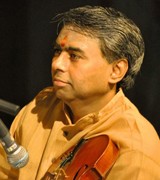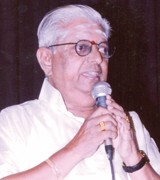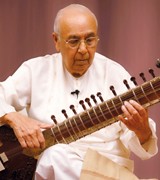COVER STORY
R.K. SHRIRAMKUMAR - A class act
V. Ramnarayan

He is the preferred violin partner of many a senior Carnatic vocalist. A master of the art of accompaniment, he scrupulously restrains himself to faithfully follow the contours of the essays of the main artist, yet manages to carve out his own nuanced brand of manodharma when the flow of the concert inspires him. His solo concerts are models of virtuosity tempered by restraint. Few musicians seem to have internalised the essence of the great Carnatic ragas as violinist R.K. Shriramkumar has. In the art of violin playing he has over the years undergone systematic evolution and transformation from a correct if unexciting purveyor of pure music to an exemplary explorer of raga music on a rich, wide canvas, but with his hand and mind firmly on the brakes to shut out mindless, reckless abandon. Mention any raga to him and he can paint you a masterly portrait of it without so much of a warming up, each gamaka that flows from his instrument unfurling the DNA of the raga flawlessly, its aesthetics fully revealed, yet without excess of any sort. Some of his admirers have examined his music ultra-critically, only to come up reluctantly with perceived weaknesses that could actually be strengths that he is not a `kanakku’ wizard, and that in embracing the vocal style in totality he has perhaps not explored the violin’s instrumental possibilities adequately.
Shriramkumar has inherited the impeccable legacy of the Sanketi-speaking Rudrapatnam family of musicians from Karnataka. A grandson of eminent violinist R.K. Venkatarama Sastry and a grandnephew of Sangita Kalanidhi R.K. Srikantan, he was born on 4 October 1966 to Kusuma Krishnamurthy and R.V. Krishnamurthy. He had his early music lessons from Savitri Satyamurthy and advanced training from his grandfather. He was also one of the prominent students of vocal music taught by the late D.K. Jayaraman in his heyday. At present he receives mentoring from violin maestro V.V. Subrahmanyan.
SPECIAL FEATURE
B.M. SUNDARAM - Beautiful contributions to music and dance
A. Sambandam

B.M. Sundaram is hailed as a multilinguist, research scholar, musicologist, writer, composer and an eloquent speaker. On 27 March 2016, students of Vani Sangeetha Vidya Gurukulam where he teaches music, organised a function to celebrate the 81st birthday of the octogenarian.
Bala Meenakshisundaram Sundaram – popularly known as BMS – derives his name from his mother Balambal and his father Meenakshisundaram Pillai, the great tavil maestro from Needamangalam. He was born on 10 October 1934. He was the first disciple to learn music in gurukulavasam from Mangalampalli Balamuralikrishna. He has a M.A. in Music and Ph.D in Musicology.
WAY OF LIFE
ARVIND PARIKH - A guru in the best Vilayatkhani tradition
Meena Banerjee

Guru Poornima, which falls on the full moon day in the month of Ashadha, is widely celebrated by students of the Indian classical arts even in this era of drastically changed value systems. In the oral tradition of Indian arts, the guru who personifies wisdom, plays a pivotal role in the transformation of the sishya. It is he who transmits the knowledge handed down to him across generations by unravelling the mystery behind the scriptures and certain rituals or practices associated with the art.
Pandit Arvind Parikh, a committed researcher and guru, has infused new life into this age-old Indian tradition. The auspicious occasion of Guru Poornima stands for a special reunion for the ‘Parikh Parivar’ formed by his disciples. This year the Guru Poornima celebrations were conducted from 15 to 17 July at the Rajarshi Shahu Sabhagruha of Shivaji University, Kolhapur. Thirty select disciples of Arvind Parikh performed on instruments like the sitar, surbahar, shehnai, violin, and sarangi; there were a few vocalists too. The festival commenced with Hassan Haidar’s shehnai. He was joined by sitarist Ramprapanna Bhattacharya in a jugalbandi with tabla artist Anutosh Degharia in a surprise finale.
INSTITUTION
The Lewis Foundation of Classical Ballet
Yana Lewis in conversation with Srilatha Krishna

It is difficult to associate the art of classical ballet with underprivileged children as ballet dancing invariably invokes images of sophistication, scale, space and perfection, which probably are distant goals for the disadvantaged in society. So, when I learnt that an institution had not only managed to groom ballet dancers in Bengaluru, but also used the art form to empower disadvantaged children, I just had to find out more.
Yana Lewis, a native of London, ballet performer, teacher and choreographer came to India to attend the 80th birthday celebrations of her yoga guru B.K.S. Iyengar. The spirituality and simplicity of the Indian way of life appealed to her and she decided to stay back, making India her home. She put her ballet qualifications to immediate use and started conducting ballet workshops in Mumbai in 1999 and later started offering full time ballet classes. In 2006, she, along with Devang Bhanushali, started the Lewis Foundation of Classical Ballet in Bengaluru with a clear objective of taking ballet dancers from India to the forefront internationally.


